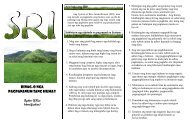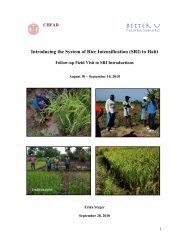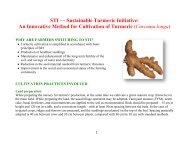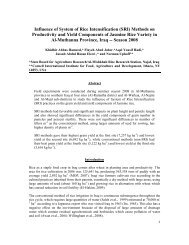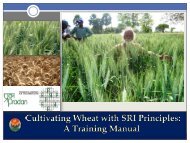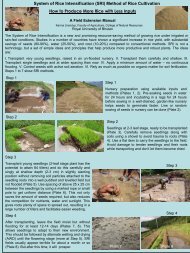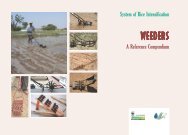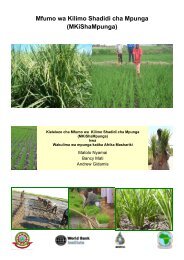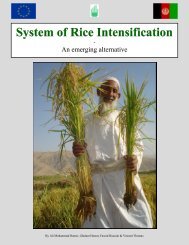EFFECT OF THE SYSTEM OF RICE INTENSIFICATION (SRI) ON ...
EFFECT OF THE SYSTEM OF RICE INTENSIFICATION (SRI) ON ...
EFFECT OF THE SYSTEM OF RICE INTENSIFICATION (SRI) ON ...
You also want an ePaper? Increase the reach of your titles
YUMPU automatically turns print PDFs into web optimized ePapers that Google loves.
Table 9. An estimated C budget. It is assumed that farmers convert all their land to <strong>SRI</strong> and have an annual<br />
compost production of 3t/ha and a rice yield of 3.5 t/ha.<br />
Inputs kg C ha Specifications References<br />
Roots 210 Undecomposed<br />
42% C estimated from Brady & Weil, (1999a).Root<br />
shoot ratio estimated from Yoshida (1981) to be<br />
0.1<br />
Stubble 110 Undecomposed<br />
42% C estimated from Brady & Weil, (1999a).<br />
Stubble estimated to be 5% of the straw mass<br />
(5.25 t/ha)<br />
Compost 1050 Undecomposed C% of the compost is estimated to be 35%<br />
Total 1370<br />
Losses<br />
Roots 141 67% lost Estimated from Brady & Weil (1999a)<br />
Stubble 94 85% lost Estimated from Brady & Weil (1999a)<br />
Compost 788 75% lost Estimated from Brady & Weil (1999a)<br />
Total 1022<br />
Net balance 348<br />
Soil C pool =<br />
49.5 t/ha<br />
A perfect <strong>SRI</strong> system as described by e.g. Stoop et al., (2002) compared to conventional rice<br />
systems will most likely emit less amounts of GHGs and increase C pools due the water<br />
management involving several drainage periods. The <strong>SRI</strong> practiced by the targeted farmers within<br />
this project does not seem to possess the means of really affecting a decrease of GHG emissions due<br />
to no water management. The potentials of increasing the C pool does however seem more<br />
appropriate for the RPF in Prey Veng with the input of 500.000 trees over the next years.<br />
On the basis of the discussion on GHG emissions and C sequestration, it is tempting to state that<br />
<strong>SRI</strong> is moving the target farmers’ livelihood sustainability towards a new and higher level. Or as<br />
stated by Pretty (2000) on the definition of a sustainable farming system being one that:<br />
“..sequesters carbon in soils through organic matter accumulation both contributes to the global<br />
good by mediating climate change and the private good by enhancing soil health”. RPF can turn a<br />
rice based farming system emitting large amounts of GHGs into a sustainable one (such as <strong>SRI</strong> or<br />
other systems) through C storage and develop a beneficial system with long term effects on<br />
increased soil quality and productivity. By reducing the emissions of GHGs, soil C is increasing in<br />
combination with applied organic materials and soil fertility can increase hence have a large<br />
positive influence on their livelihood strategies and future life.<br />
69



